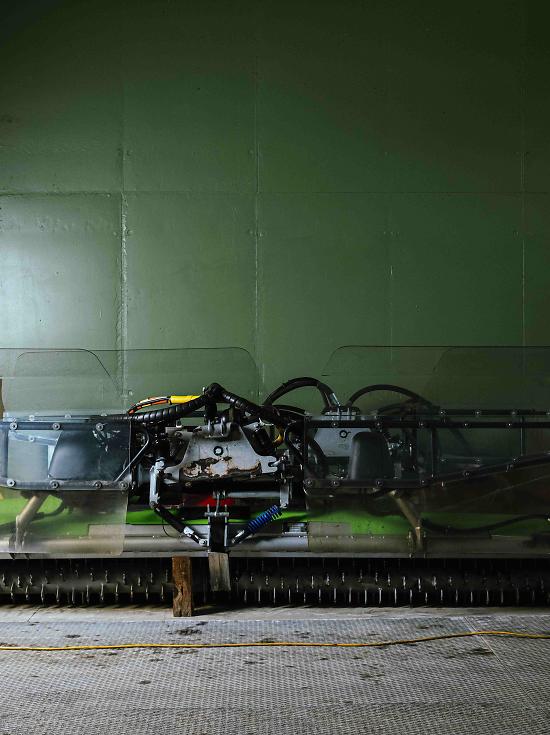
Between Heaven and Earth
Interview with snowcat driver Julia Moling
Like a firefly in the night, like a centipede, she works her way forward as calmly and as steadily as a tortoise, as strong and agile as a puma. Eleven tons, about ten metres long and three metres high, 400 to 500 horsepower. And in fact, she moves just like a cat smoothly over steep slopes and gentle hills, always following the natural incline, adjusting to the snow conditions and the slope. Powerful, elegant, dancing, sometimes pirouetting. The result is a perfectly groomed snow surface – the outcome of hard work and a unique bond between human and machine. Surrounding her is the stunning landscape of the Alta Badia: majestic mountains, dense forests, fresh, crisp, cold air, soft pastel light. Everything awakens the senses.
When Julia Moling drives her machine over the glistening slopes, her music plays on the radio in the cabin. She is alone with her thoughts, always highly concentrated, feeling a sense of satisfaction. Sometimes, one of her four colleagues joins her, and they exchange a few words. In the late afternoon, as dusk falls, a special fleet enters the colours and shades of the night. The woman from Gadertal is one of them. After a brief stint in the hotel industry as a cook and waitress, she began driving a snowcat at the age of 19.
The passion with which Julia Moling dedicates herself to her job and her deep understanding of nature's ever-changing conditions are clearly evident. Her work and the challenge of perfectly preparing the slopes for guests is not only a technical achievement but also a tribute to the beauty and diversity of the Alpine landscape. Now, at 26, she is in her sixth season driving the slopes of Alta Badia. From the Grödner Joch, she gazes at the Sella Group. How it feels to work daily, or rather nightly, in such a fascinating environment is something Julia Moling tells us about in this interview.

Tell us a bit about yourself: Who is Julia Moling? What are you passionate about? What shaped you?
I grew up in La Val, just outside the village, with two older brothers and a younger sister, and I had a beautiful childhood. The mountains and nature were always present. This shaped me and strengthened my love for them. I am a true family person; I love it when everyone gathers together for celebrations. Now, I live in Corvara, where I still appreciate a peaceful environment near the forest and mountains. Of course, I go on holiday in big cities and by the sea, but I always look forward to returning to the mountains, where I feel at home and enjoy the tranquility, for example, on trips with my dog. The slopes of Colfosco hold many beautiful childhood memories: In winter, I would go up from La Val with my father in the mornings; he went to work, and I spent the whole day skiing. Colfosco has always been my place.
How did you become a snowcat driver?
I often went out with my boyfriend in the snowcat, and jokingly said: “I like this.” He provocatively replied: “Then do it.” He didn’t believe that I would actually put my enthusiasm into action and be behind the wheel of a snowcat the following winter, at the age of 19. After a theoretical introduction course, it was “learning by doing.” My brother is also a snowcat driver. It requires sensitivity, foresight, and of course, experience.
Tell us about a typical workday – or should we say night: When does your work begin?
My worknight begins half an hour after the lifts close, around five or five-thirty in the afternoon. We check the machine ourselves, clean it, and grease it before starting. Then we go, each on our assigned slopes, everyone knows what to do. Whoever finishes earliest helps the others. Depending on the snow consistency and daytime activity, we finish around midnight or sometimes as late as two or three in the morning. Sunny, cold days provide perfect working conditions for us. It can also happen that it snows early in the morning, and then it’s back out on the slopes after just two hours of sleep. The challenge is to work precisely, avoiding bumps, and always paying attention to the current conditions. The snow conditions can vary greatly. When everything is perfectly groomed, you know it’s time to call it a day.


What would you never want to miss?
I am fascinated by the machine itself, its size and imposing presence. In the cabin, you are alone with your music: just you and the snowcat. Of course, we are in touch with everyone via radio. The sunsets are also impressive – I like to capture them in photos and post them on my Instagram. What I love about my job is the freedom and peace in nature. I adore the mountain views and the challenges that the different snow conditions bring. It feels good to prepare the slopes for the skiers. And sometimes, we are lucky enough to cross paths with a fox at night... This harmony, this feeling of freedom, gives me a lot.
Do you also ski on your slopes?
Yes, of course. But I prefer to ski on others sometimes. Then I tend to observe how others have groomed the slopes and get some ideas. It's fascinating to see how the conditions change and how the skiers react to them.
How many nuances does snow have?
Endless... Wet snow turns white-blue in colour, fresh snow is pure white, and the infamous Sahara snow is beige-brown like cinnamon.
Finally, a tip: What should we not miss in Alta Badia in winter?
The entire area is impressive, the mood, the atmosphere. Everything I see from the snowcat can also be admired on foot or on skis. No matter where you go, there’s always a beautiful view of the mountains. It's incredible. In Corvara, the Sassongher, the local mountain, is particularly striking. And the ski slopes lie at its feet.
Kunigunde Weissenegger, a graduate in translation and interpreting in Innsbruck, Granada and Rome and with a humanistic background and a specialisation in journalism, is a translator, writer, journalist, communication strategist and co-founder of the communication agency and publishing house franzLAB.







































